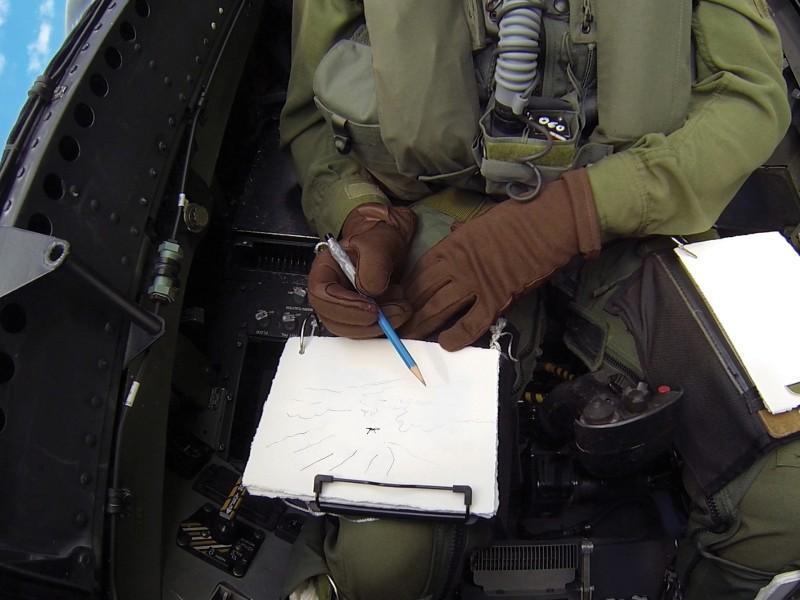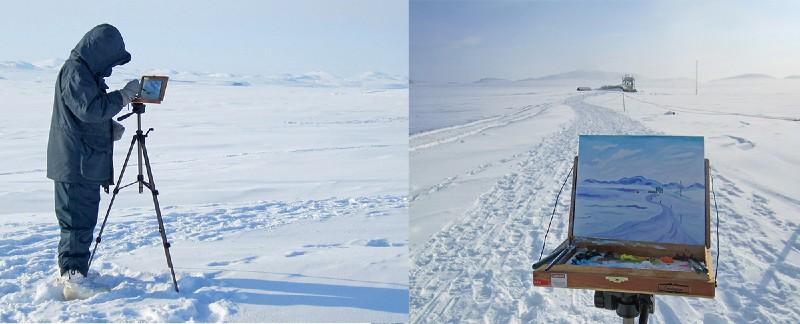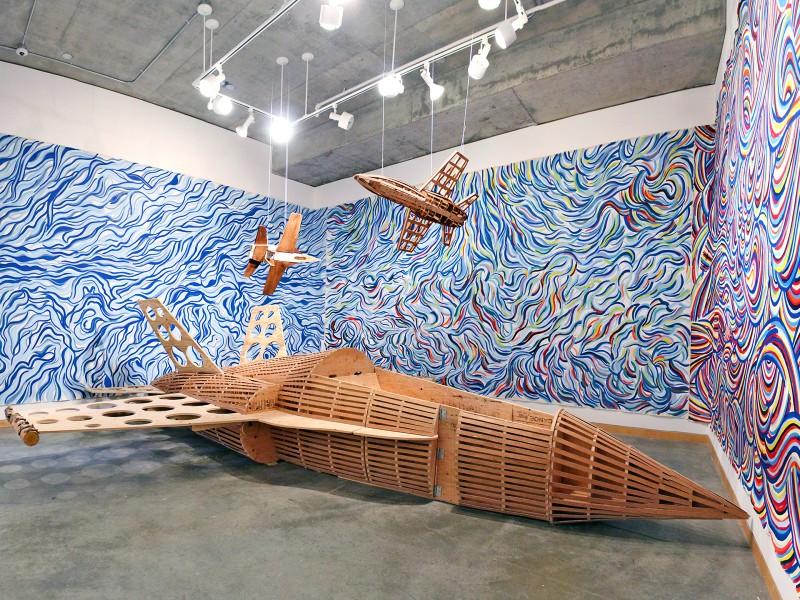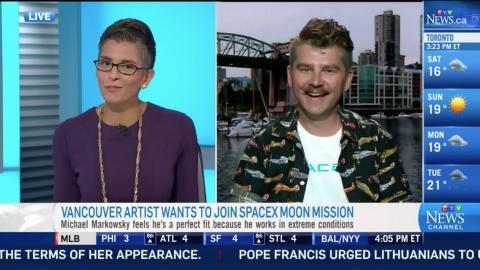BFA IN DRAWING, 1999
ALUMNI DISCOVERY INITIATIVE, INTERVIEW BY KERRY MAGUIRE, 2015

Digital Still from the documentary film "Markowsky Draws in a Fighter Plane" (Directed by Michael Peterson, 2014)
When did you graduate ACAD? What was your major? Do you continue to work in this area or did you change areas of interest?
I graduated in 1999 with a BFA in Drawing. Drawing is the core of my practice – I also do performance, video, sculpture and a lot of painting – but all of my different projects evolve out of my drawing practice. In other words, I approach painting or sculpture as a draw-er, rather than as a painter or sculptor. And I developed that mindset at ACAD, in the Drawing Program. We were really encouraged to question the traditional idea of drawing as simply pencil on paper.
What was your experience at ACAD like? How did you evolve while you were a student?
I loved it! When I came to ACAD, I thought I was going to go into design and become a commercial illustrator. In my first year, I took design classes such as digital communication and illustration, as well as sculpture and photography. But I realized pretty quickly that I didn’t have the patience required for a designer/client relationship. I have a very clear vision that I want to put out into the world, and I’m more interested in making artwork and then finding people who will embrace it. And that is completely antithetical to how a designer approaches a project.
While I was at ACAD, I did an exchange at Cooper Union School of Art in New York City. The Exchange and Mobility program is fantastic! As far as I know, I was the first person to do the exchange in New York; previously a lot of people wanted to go to more exotic locations, like Tokyo or Glasgow or Australia. But the year before I began at ACAD, I had gone to New York for the first time and seen artworks at The Museum of Modern Art that I had only ever read about in books and magazines. So being able to live in New York and go to those museums on a regular basis changed my life. I spent a lot of time at the MoMA watching movies from their vast film archive, and sketching famous paintings. In that respect, it was fantastic.
But despite how incredible my time was in New York, I also realized how great we had it in Calgary. Cooper Union is located in the East Village, in an incredibly awesome, vibrant neighbourhood, across from the famous rock n’ roll bar, “CBGBs,” which is now gone. It was a really exciting place to be. But each day, as soon as classes were over, all the students disappeared into the surrounding neighborhood. No one hung around.
However, at ACAD, people actually hang out on campus after class: there’s a community which is vitally important. I teach at Emily Carr in Vancouver these days, and I tell my students that while it obviously helps to have great teachers, the most important thing about art school is the people you go to school with. Peers are the people that you will grow old with and the people that will form your community for the rest of your life.
I met a whole bunch of incredible people at ACAD. Even though I moved to London, England after ACAD to go to Graduate School at the Royal College of Art, and then to the Art Center in Los Angeles – where I ultimately graduated with my MFA and ended up living for nearly 12 years – to this day, all of my closest friends are people that I was in school with at ACAD. All of them.

Digital Still from the documentary film "Markowsky Draws in a Fighter Plane" (Directed by Michael Peterson, 2014)
What insights did you take away from ACAD when you look back at things?
ACAD changed my life! As I said, I made great friends there, but I also had excellent teachers. The biggest turning point in my life happened because of one of my teachers at ACAD.
Richard Halliday was a big influence on me and I’m sure for everyone who took classes with him. I took every class I could with him. During my second year, I got into this bad habit of waiting until the night before a project was due before beginning to work on it. I remember once, at the beginning of a critique of my work, Richard looked around the room at what I had dashed off and then just got up and left. Everyone in the room was shocked. Other students chased him down and convinced him to come back. And so he did, he came back and sat there, but he was so pissed off because we both knew that my artwork was a joke. As I said, I had just tossed it off the night before.
I was so embarrassed and I remember thinking afterwards: “This guy takes his job seriously, he takes art seriously, and I’m just wasting his time. What do I want to do with my life? Why am I here? What is the purpose of this? I want Richard to take me as seriously as he takes art.” That was a really formative moment of my life; that was the moment in my life where I decided that I was going to dedicate myself to being a capital-A artist.
ACAD exposed me to towering figures like that, people who challenged me and challenged my idea of what art is, and challenged who I was as an artist and ultimately who I was as a person.

"Painting at the North Pole" Michael Markowsky painting G.A.W. Lab North Pole II April 22 2012 8x10 (20x25.cm) Oil on Masonite Panel (2012)
Given your experiences, what advice would you give a student when it comes to establishing a creative business?
Well, the most important word you said there is “business.” I don’t care what anyone else says, being a professional artist is a small business. I run a small business; I have to file taxes and claim business expenses just like any other Mom and Pop shop. I used to think that all I have to do is make really good art, and people will just come out of the woodwork and buy it. But that’s ridiculous. You have to be proactive and be your own advocate, just like someone making cupcakes or repairing mufflers has to do. You have to be highly self-motivated, committed, and determined. I am my own boss; if I decide to sleep in every day, no one is going to fire me, which is great, but if I do it all the time, I’ll be sleeping on the street.
The great thing about being an artist is that I get the satisfaction of creating something interesting and unique that has never existed before. But trying to find a home or market for it is difficult. I recommend that every artist take a business class, which is what I did. And I also recommend every artists develop some social skills! I know it sounds funny, but you need to be able to have conversations with strangers about your artwork and ideas. I feel sad when I see artists who are afraid and are unable to do this.
I guess like any other small business owner, you have to be really excited about what you’re doing. People are attracted to people who have something to say – and who can tell it in a compelling way. Be proud of what you do! I actually would recommend that every artist – no, every human – take an improv comedy class. There are social skills you can pick up, you learn how to be comfortable talking and playing with strangers, and it’s also been very helpful for just reminding myself that you can be creative spontaneously. I know that I can just sit down and make art out of thin air; I don’t need to wait for inspiration to magically strike before I can begin.

"Faster Than the Speed of Sound" installation view at the Kamloops Art Gallery (2014)
I know it might make some people’s ears bleed to hear this, but I think every artist needs to prepare a little elevator pitch, so that if you run into somebody at a party, you are able to answer the question; “What kind of art do you do?” That really helped me get over my own anxiety, because I didn’t have to scramble to come up with an answer on the spot. So, it made it easier and even fun to go out and meet new people who weren’t artists. And it made it easier to other people too, because generally artists are socially awkward and talking to us can be really painful! I’m not talking about being inauthentic. I’m talking about being prepared. Being prepared opens up all sorts of doors.
For example, I had a big show in Edmonton in 2014 and initially I declined to put text panels up, because when I go to a museum or gallery, I never read them. I prefer to just go in and “read it cold.” So anyway, I was in the space painting throughout the exhibition, and people would come in and look around, and either just leave or come up and ask questions, because they were totally confused about what this or that was. Finally, after a couple of weeks, I wrote and put up a text panel, and instantly the whole conversation changed. Strangers were coming up to me with much more informed questions and we’d end up talking for a long time. The fact is, the majority of people have never even been inside of an art gallery. They don’t have all the tools you pick up when you go to art school that help you understand an artwork you’ve never seen before. So, if you make it difficult – like I had initially done in Edmonton – they might get turned off and never go into another gallery again. And that’s not just bad for all artists, it’s bad for the world.
Lastly, it’s so important to create your own opportunities. You have to come up with creative ways to get your stuff in front of other people’s faces. What I like about Sled Island and other alternative art venues is that they aren’t managed by the usual gatekeepers like curators and galleries who pick and choose who gets to exhibit in the fancy white cubes. If you’re an artist applying for exhibitions or grants and things aren’t working out, rather than giving up, rent a space, or have a guerrilla exhibition on the C-train, or do some performances outside, make some YouTube videos, whatever. Rather than waiting for the approval of other people, just do it. And oddly enough, these kinds of gestures are precisely the kinds of things that get the attention of the gatekeepers because it shows your enthusiasm for art, your motivation to get it out there. That’s exciting for old fuddy-duddies who have been in the so-called “Art World” for a while. They want to see someone who has so much energy that they are going to make art no matter what.
How could you imagine ACAD supporting our alumni?
I’m glad you asked. Firstly, it’s important to be consulted. And it’s important for faculty, students and alumni to stand up for what we think is the mission of the school, and not to lose sight of what these priorities are. Every once in a while, someone from ACAD will reach out and ask me to be a part of an initiative or a discussion, which is always great. I was recently invited to an event in Vancouver when ACAD’s President came to visit. It’s nice to know that people who are carrying the torch for ACAD today are still keeping an eye on you and want you to be involved. That’s how you build community. I think this kind of thing, [the Alumni Discovery Initiative] is really good.
I’d like to do more mentoring and partnering up with current students and recent graduates, possibly over an extended period of time. When I lived in Los Angeles, I worked for a bunch of different artists and that was really eye opening, seeing how they organized their studios, their businesses and their lives.
In grad school, they partnered us up as mentors with undergrad students and I ended up hiring this one student for an entire year. 15 years later, I’m still in contact with this former student of mine, and he’s now a successful filmmaker down in L.A. That’s really exciting for me to give back, because I also had the opportunity to be mentored by artists and those were really important opportunities in my life. I will say that it can be really hard to find a mentor, so it would be good to see a formal process that assigns students a mentor, or gives them some existing choices, that would make the whole problem of finding one easier.

Michael Markowsky being interviewed his plan to paint on the moon on CTV News (September 22, 2018). Full interview can be seen here.
What do you feel is the role of ACAD and our alumni in shaping our cultural and economic prosperity?
I think ACAD is the cultural soul of Calgary. Especially back when I was in school in the late 1990’s, ACAD was where anyone who didn’t fit in anywhere else in Calgary went. Anybody who dressed differently, listened to different kinds of music; anybody who was an outcast in high school or society could go to ACAD and be accepted there.
Being a place where they can feel comfortable being themselves is an incredibly important, if unspoken, role for ACAD to play within the larger community. I’ve never met anyone who went to ACAD talk about it as having been a waste of time, even if they didn’t graduate. That’s my anecdotal experience anyway. Everyone talks about it as having been an incredibly formative place that shaped who they eventually became.
So, I’d really like to see ACAD embrace that even further, so that the citizens of Calgary and Alberta see the University as a place where all people are accepted, where new and controversial ideas can be shared and talked about and debated openly. Our society needs places like ACAD now more than ever. Hosting public talks and events, challenging people outside of the school, that is where ACAD can play an even greater role.
Looking back at our #ACADcreativitymatters campaign, why do you think that creativity matters in the big picture?
People are attracted to and seduced by creativity. The vast majority of people don’t consider themselves creative – even though I believe we are all creative in our own way – people who don’t make art, don’t make songs, but they love covering their walls in art, going and seeing live music, reading books, etc. They want to meet artists, they want to talk to them and learn about their artwork. Every time I have an exhibition, it’s inevitably the people whom I have talked to who end up buying the artwork. They get excited because now they can explain the story behind the painting to their friends and family.
One of the first things I tell students at Emily Carr is that every artist feels at some point like they are alone and isolated, in their studio by themselves, doing something for the first time. But in actuality, we belong to this massive, invisible, secret society. There are hundreds of millions of us artists, all over the planet. Even people who don’t consider themselves to be artists, they – we all intuitively understand what it’s like to be an artist; to struggle to express ourselves, to face rejection, and so on. So, you’re never alone. You’re probably standing next to another artist on the bus and neither of you even know it! So, expressing yourself gives other people the courage to express themselves too. And if everyone expressed themselves through a creative outlet, rather than through other destructive or violent means, or suppressed their emotions and thoughts through drugs and so on, the world would be unrecognizable, in a good way. That’s why creativity matters. It’s really all that matters, as far as I’m concerned.
See Michael's Instagram